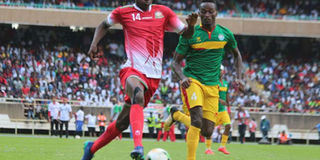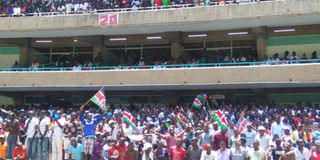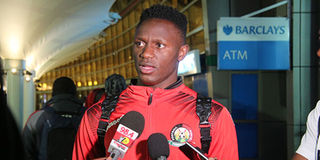Harambee Stars deserve better countdown to Afcon campaign
What you need to know:
- Kenya’s return to Africa Cup of Nations after 15 years should inspire an outbreak of creativity and make a good turn in the direction of professionalism. But where is the new kit? Where is the new name? When is that state-of-the-art team bus getting unveiled? Is it business as usual?
- Tanzania has gone to the Nations finals only once in the past – in 1980.
It doesn’t matter that during this year’s Africa Cup of Nations, Harambee Stars is grouped with two countries one of whom I suspect will win the tournament – and it is not Tanzania on my mind. What matters to me is the pedestrian approach that the country has adopted in the countdown to this competition that grows in prestige with every edition. Surely, returning there after 15 years should inspire an outbreak of creativity and make a good turn in the direction of professionalism.
Where is the new kit? Where is the new name? When is that state-of-the-art team bus getting unveiled? I mean, is it business as usual?

Kenya's Harambee Stars coach Sebastien Migne appreciates fans before their 2019 Africa Cup of Nations Group "F" qualifier against Ethiopia at Moi International Sports Centre, Kasarani on October 14, 2018. PHOTO | CHRIS OMOLLO |

Kenya's Harambee Stars midfielder Dennis Odhiambo challenges for an aerial ball during their 2019 Africa Cup of Nations Group "F" qualifier against Ethiopia at Moi International Sports Centre, Kasarani on October 14, 2018. PHOTO | CHRIS OMOLLO |

Harambee Stars striker Michael Olunga (left) dribbles past Ethiopia's Antech Tesfaye during their 2019 Africa Cup of Nations qualifier against Ethiopia at the Moi International Sports Centre, Kasarani on October 14, 2018. PHOTO | KANYIRI WAHITO |

Fans at the Moi International Sports Centre, Kasarani on October 14 ahead of the crucial 2019 Africa Cup of Nations (Afcon) qualifier pitting Kenya's Harambee Stars against Ethiopia starting 4pm. PHOTO | VINCENT OPIYO |
I can’t forget how Nigerians awed the world with their new kit during last year’s World Cup, although they seem to have believed that the dazzling outfit might do most of the playing for them which couldn’t happen. Still, it was a great spectacle and that is what football at the highest levels always is.

Nigeria's Super Eagles pose for a group picture ahead of their Russia 2018 World Cup Group D match against Iceland at the Volgograd Arena in Volgograd on June 22, 2018. PHOTO | FILE |
Cameroon’s Indomitable Lions once took even Caf and Fifa by surprise when they showed up in sleeveless tops like basketballers and shorts that hugged their bodies. Since the British started the game of football, fans had never seen such a brazen display of sinewy muscles.
Fifa’s people scrambled for their etiquette books and decided no, no, you can’t dress like that. But although that particular kit had to go, it was not the last we saw of Cameroon’s sartorial audacity.
Even this year, they have already unveiled their Egypt kit – and it is looking very nice. Like Kenya, Ghana, Nigeria and many other African countries, Cameroon, the continent’s most successful World Cup campaigner, may be infamous for chronic incompetence when it comes to managing their teams – what will all those never-ending stories about player boycotts over unpaid allowances.
But unlike Kenya, they have plenty going for them and generation after generation of players, they are always a contender for the top prize.
In a previous column, I have urged that we change the name Harambee Stars. Sometimes, changing a brand for its own sake is a valid enough reason to do that. But change also signifies renewal, an aspiration to become better.

Harambee Stars captain Victor Wanyama speaks to the media at the Jomo Kenyatta International Airport on October 11, 2018 after the team's arrival from Ethiopia where they played out a 0-0 draw in a 2019 Africa Cup of Nations qualifier. PHOTO | KANYIRI WAHITO |
CHANGE NAME
Since 1976, the national football team has been known as Harambee Stars. That is long enough. Harambee is not even fashionable as a means of national development as it was 43 years ago and has over the years gained notoriety for the abuse that it invariably attracts.
Isn’t this the best possible time to give Kenyans a chance to select a new name for the national team? Kenyans are part of a vocal campaign in the world that makes it clear that ivory belongs to elephants.
Elephants are part of our national heritage and I cannot find a proper reason why the national team cannot adopt their name. Rhinos and lions, too.
There probably may be legitimate apprehension that giving the team names so majestic only for it to become the favourite punching bag of the continent’s minnows is risky.
The name could become everybody’s laughing stock. Moreover, when the usual scandals break out, people could complain and with good reason that we gave the good animals a bad name. But again, there is nobility in sincere endeavour, in working towards a good dream, however long the odds. It is a question of aspiration. Achievement comes later.
Anyhow, the late Kenneth Matiba, the man who decreed the name Harambee Stars, used to have a political catch phrase. It went: ‘Let the people decide.’ It is time to retire this name and let the people decide a new one. And anybody who suggests that we call them the Hippos of Manguo Marshes must not be allowed to have his way. He should be snapped in half.
I will probably pay more attention to this year’s Afcon than to any in the past. For the first time, all our good neighbours are present and in the big stage of the continental showpiece, there will be some sibling business to attend to.
The Cecafa region has never had it so good. For the first time in the 60-year history of this competition, all three countries that made up the original East African Community – Kenya, Uganda and Tanzania – are in it.

Kenya's George Odhiambo is tackled by Tanzania's Himid Mao during their Cecafa Senior Challenge Cup Group A preliminary match on December 11, 2017 at Kenyatta Stadium, in Machakos County. PHOTO | CHRIS OMOLLO |
LONG WAIT
Tanzania has gone to the Nations finals only once in the past – in 1980. The three countries are joined by Burundi, a later entrant who are Afcon debutants and it will doubtless be fascinating to see how well they acquit themselves.
But the more fascinating contests will be those involving eternal sibling rivals Kenya and Uganda although their paths may not cross.
Between them, they have previously qualified for the tournament 11 times: Uganda six and Kenya five. But whenever one was in, the other was not.
The competition was first held in 1957 and the Cranes, as the Ugandan national team is christened, had featured in 1962, 1968, 1974, 1976, 1978 and 2017.
Kenya first participated in 1972, followed by 1988, 1990, 1992 and 2004. Kenya and Uganda are the bitterest of football rivals.
The concept of a friendly match does not exist in the minds of their supporters; it is always a keen contest sometimes described in war terminologies.
The beauty of football is that it not just the track record of winning the big cups that always counts. Two countries – or two clubs – may be small fry on the international scene but when they lock horns, you cannot tell that from the passion they generate among their supporters.
In Africa today, Kenya and Uganda don’t sit at the high table. They are nearer the rear entrance. But wait till they meet. The party gets going in a big way. Their rivalry still ranks up there with the fiercest in the continent – Egypt versus Algeria, Ghana versus Nigeria, Senegal versus Cote d’Ivoire and Zambia versus South Africa.
The irony of the rivalry between Kenya and Uganda is that it was fomented in an era when a country called East Africa existed in all but name. Connected by a vibrant infrastructural network that went by names such as East African Railways and Harbours, East African Airways and East African Posts and Telecommunications, every sport played by the peoples of Kenya, Uganda and Tanzania gave the name East Africa to its top competition.
Thus, for football, the East African Challenge Cup was the region’s premier tournament while in motor sports, it was the East African Safari. This one was so prestigious across the world that pundits christened it “the toughest test of man and machine” and nobody seemed to dispute it. There was an East African Cup in almost everything – boxing, volleyball, athletics, netball etc.
It was an era when the non-existent country routinely fielded one team. When West Bromwich Albion, the 1967 English FA Cup champions toured the region in 1968, they played two games against East Africa.
International cricket matches regularly featured an East African side against a diverse array of opponents from Asia and Europe. Some sports, like snooker and billiards, organised themselves in regional terms with the East African Billiards Control Council at the helm.
Currently ranked 75th by Fifa, Uganda missed the 1978 Afcon title by a whisker, losing 1-2 to hosts Ghana in a hard-fought final in Accra.
The late dictator, Idi Amin Dada, himself a notable sportsman as the country’s former heavyweight boxing champion, spared no expense in supporting his kindred spirits. His reign may have been the country’s darkest period as a country but his sportsmen and women weren’t complaining.
The honeymoon ended the following year. Fed up with his perennial provocations, President Julius Nyerere sent his army, the Tanzanian Peoples Defence Force alongside Ugandan exiles to remove the dictator from power.
Amin fled to Libya and onwards to Saudi Arabia where he lived out the rest of his life leaving his orphaned sportsmen and women to bear the brunt of pent up hatreds. For like in neighbouring Kenya, most of them were drawn from the armed services – the army, the police and the prisons.
The peoples’ ire was turned on them and many fled to Kenya to save themselves. It would be years before the country could regain its footing on the international sporting scene.
In qualifying for 2019 Afcon, Uganda made it twice in a row but before 2017, they had waited an agonizing 39 years – since 1978 - to make their return.
Upon qualification for Afcon 2019 last year, fans in Kenya expressed great delight – but with a caveat. They hoped this would be the start of good things to come but feared it was a flash in the pan.
They pointed out the chronic problems in the game, such as technical staff going for months on end without pay. But the fans who cheered these two countries and lived in that East Africa country that almost existed in the 1970s are very different from todays’ crowd.
Things have changed – and radically. First, the East African identity was discarded for a rabid nationalism that sometimes startles in its ferocity.
Technology, which has virtually erased distances in time and space, has only made it easier and faster to express their prejudices.
In purely technical terms, the gulf between North and West African countries and East Africa is wide. The three Cecafa states are therefore not expected to proceed beyond the group stages.
After this happens, fans will briefly flood social media with the most cynical comments about what should have happened.
They will curse the incompetence and corruption bedevilling their sports federations. But this will only be a momentary distraction from where their attention is permanently fixated – the English Premier League. This means the world to them.
In the 1970s, football fans could engage sports editors for months on end about the fortunes of their team in major tournaments like Afcon and the East African Challenge Cup.
But today, Afcon, whatever its size and prestige, is a distraction from the EPL. This is how badly today’s fan has become alienated from the native superstars who were worshipped.





